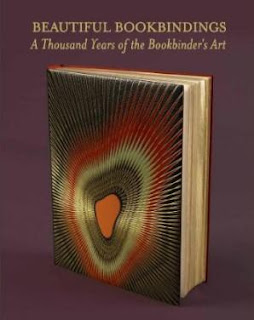PJM Marks. Beautiful Bookbindings, A Thousand Years of the Bookbinder’s Art. New Castle & London : Oak Knoll Press & The British Library 2011. ISBN 9781584562931. 190 pp. $49.95.
Reviewed by Beth Doyle
Beautiful Bookbindings is a collection of bindings selected by the staff of the British Library primarily to “please the eye.”[1] The introduction includes a brief history of the book, illustrations of book anatomy and explanations of the economic and design influences that changed the way books were made over the centuries. The bindings are presented chronologically in six chapters starting with pre-16th Century and continue through the 20th Century. Additionally there are several “special themes” that highlight furniture, embroidered bindings, painted edges, and other notable binding details.
The history of bookbinding is a vast and complicated one that spans the globe through many centuries. Beautiful Bookbindings focuses primarily on the Western tradition although the author does acknowledge, and the book briefly highlights, bindings from non-European geographies. There are prime examples of Persian lacquer bindings [2] , Indian pothi [3] , Chinese red lacquer bindings [4] , and traditional North African bindings [5] that give the reader at least a minimal understanding of what books from non-European countries might look like.
Each binding is accompanied by a short text describing what makes it special, how a specific binding was produced, or who may have commissioned or used such a book. It highlights well-known designers and artisans including William Morris [6] , Francis Sangorski [7] , Philip Smith [8] and Alice Morse [9] but also shows work from lesser-known binders. Many of the early bindings represented here are Christian texts and the author accurately describes the religious symbols found on the covers, something that is remarkably missed in many publications. But you would expect this level of breadth and accuracy from a British Library publication.
The bibliographic notes on each page are sparse, listing only the place of publication, size and a brief citation with more descriptive titles and footnotes listed by page number at the back of the book. Be sure to place a bookmark at the “Notes and Further Reading” section so you can flip back and forth to figure out exactly what you are looking at. It may also be helpful to have the British Library’s online catalog open if you are interested in finding additional bibliographic information.
When presenting artwork or fine craft it is important that the design and production aids the close study of the subject. Each binding in this book is expertly and beautifully photographed and presented in a way that you can clearly see very fine details. The explanatory text, however, is fairly small so grab your reading glasses if you want to do more than simply look at the pictures. The binding itself is made with a high quality paper and sewn, not adhesive bound, so it should hold up to many readings.
By the author’s own admission, beauty is an individual assessment, “but who can deny the visual and tactile appeal of a beautifully bound book?” [10] If you are interested in the history of the book, or if you simply love exquisitely made objects that are beautifully presented, you won’t be disappointed with this purchase.
Beth Doyle is the Head of Conservation Services Department at Duke University Libraries. She holds a B.A. in Photography from the University of Dayton, and an MLIS and Certificate of Advanced Study in Library and Archives Conservation from the University of Texas at Austin Graduate School of Library and Information Science.
[1] introduction (pg. 17)
[2] pg. 65
[3] pg. 23
[4] pg. 96
[5] pg. 24
[6] pg. 141
[7] pg. 154
[8] pg. 178
[9] pg. 144
[10] introduction (pg. 8)

No comments:
Post a Comment